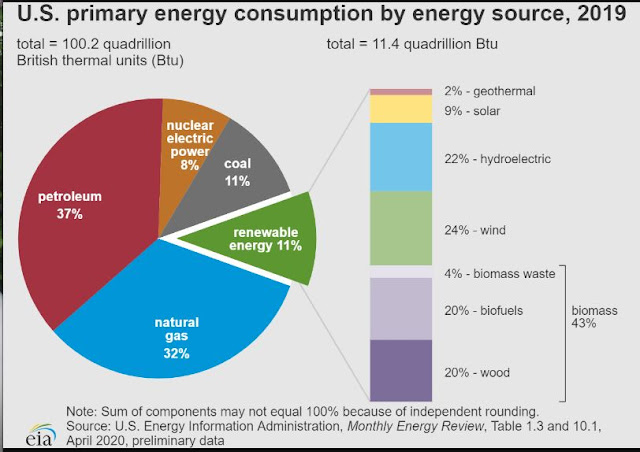FOSSIL FUELED POWER PLANTS
 |
| Typical coal power plant. Note the steam rising from the wide evaporative cooling towers and the lack of particulate matter rising from the two narrow smoke stacks. |
Let's discuss fossil-fueled power plants, their advantages, and various alternative energy sources...
Fossil fuels is the preferred energy source throughout the world. There are many reasons for this, fossil fuels (oil, natural gas and coal) is a comparatively dense source of energy. One 1.21 gigawatt power plant will produce as much power as 600 - 1,000 windmills, but those windmills only operate 10-25% of the time depending on the climate, so a single fossil fueled plant will be equivalent to the power output of 2,400 to 10,000 windmills. Unlike solar, hydroelectric or wind, we do not have to depend on the weather for our energy. This is very important for the peak demands during hot summer afternoons or cold winter mornings as electricity cannot be easily stored for later use.
While there are subtle differences between the three fuels, the same principles apply.
EFFICIENCY OF FUEL SOURCED POWER PLANTS
With the exception of solar power and batteries, all electrical generation plants run by converting mechanical energy into electrical energy by passing wires through a magnetic field within a generator. Large electrical generators will typically convert 99% of the mechanical energy into electrical power. There are another couple percentage points lost through voltage transformers, transmission lines and poor connections before the electricity is actually used in your TV set. 97%-99% efficiency is very good, and not subject to future improvements.
However, the bulk of energy lost in electrical energy production occurs in the process of burning the fuel and transforming that heat energy into mechanical energy. As with all heat engines, there is an upper limit to the efficiency that can be achieved. In thermodynamics, Carnot's theorem states that:
What this equation states is that the greater the difference between the hot and cold sources, the more efficient an engine can run at. For example, if we lived on the surface of the sun, there would be no way for a heat engine to run, despite the vast amounts of energy available. There needs to be a cold source to create a thermodynamic potential for which the engine to run, much like an electrical motor needs a voltage potential for it to run. Birds can sit comfortably on a wire carrying 13,800 volts because there is no potential across the bird, even though the bird is subjected to high voltage. That is why the top picture shows massive cooling towers, they provide a location to dump the heat to so the heat cycle can continue. Also, because of real world inefficiencies such as bearing friction, crappy insulation, crappy maintenance, noise and other problems, this theoretical maximum efficiency will never be achieved.
This equation also shows that the greater the temperature difference, the greater efficiencies can be achieved. If a certain fuel can burn hotter than others, the power plant can achieve better efficiencies. For this reason, there is a discrepancy in efficiencies based on fuel source. But as with anything, with increased running temperatures come increased likelihood of failure, and increased severity of failures.
Normal Coal Plants 32-42%
Supercritical Coal Plants 45-48% (600C steam at 300 bar of pressure)
Normal Natural Gas 32-38%
Supercritical Natural Gas 60%
Diesel Plants 35-42%
Normal Nuclear 38% (Nuclear also has waste heat of byproducts, which brings efficiency down to 0.27% if that is included)
Next Generation Nuclear ? (I'll get into that in the future)
https://www.brighthubengineering.com/power-plants/72369-compare-the-efficiency-of-different-power-plants/
COAL AS A SOURCE
Although waning in popularity, coal has the largest reserves available. Depending upon which group you get your information from, we have hundreds to thousands of years of reserves available. Unfortunately, coal also has the most impurities as a fossil fuel energy source. Compounds such as sulfur, radon, mercury, selenium, arsenic and nitrates are common. However, our coal deposits are abundant. Depending on the literature, there are 300-2000 years worth of left energy in the known reserves alone. Dirty, but plentiful and available. China is leading the world in coal energy production, by a long ways.
 |
| China, India, and Indonesia are responsible for the red. |




Comments
Post a Comment